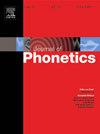语音趋同的目标:音高重音模仿的声学和语言学方面
IF 2.4
1区 文学
0 LANGUAGE & LINGUISTICS
引用次数: 0
摘要
语音趋同研究表明,说话者会模仿他们所接触到的语音模式(例如,Pardo 等人,2013;Nielsen,2011)。然而,目前还不太清楚说话者在改变其说话行为时是在对语音信号的哪些方面做出反应,以及在多大程度上做出反应:特定的声学值、语言解释的目标,还是某些组合。为了探究这个问题,我们进行了两项模仿实验,一项是让受试者接触语言学上有意义的受控音高重音实现,另一项是让受试者接触语言学上无意义的整体音高差异。语音趋同可能以语音信号的声学值为目标,导致参与者在声学上趋向于模范模仿者的低 f0 和快语速。我们的研究结果表明,两者兼而有之:参与者在语言解释目标(音调重音类型、L + H* 峰值 f0 的相对上升和目标短语的相对持续时间)和声学值(载体短语的 f0 和持续时间)上都向模范说话者靠拢。然而,我们的数据表明,较高层次的语言解释趋同可能比低层次的趋同表现得更为明显。我们还观察到,f0 和持续时间之间的收敛稳健性不对称,收敛模式也存在个体差异,这表明收敛受到刺激结构属性以及说话者感知和生产特征的制约。本文章由计算机程序翻译,如有差异,请以英文原文为准。
On the target of phonetic convergence: Acoustic and linguistic aspects of pitch accent imitation
Studies in phonetic convergence have shown that speakers imitate phonetic patterns to which they are exposed (e.g., Pardo et al., 2013; Nielsen, 2011). However, it is less clear what aspects of the speech signal speakers are responding to when they change their speech behavior and to what extent: specific acoustic values, linguistically-interpreted targets, or some combination. To explore this issue, we conducted two imitation experiments, one in which participants were exposed to a linguistically-salient manipulated pitch accent realization, and one in which participants were exposed to a linguistically-less-salient overall pitch difference. Phonetic convergence might target acoustic values of the speech signal, leading participants to converge acoustically toward the low f0 and fast speech rate of the model taker. On the other hand, phonetic imitation might target linguistic patterns in the stimuli, leading participants to imitate the enhanced pitch accent in f0 and duration, even if it would result in acoustic divergence.
Our results show that it is both: participants converged to the model talker in linguistically-interpreted targets (pitch accent type, relative rise of the peak f0 on L + H*, and relative duration of the target phrase) and acoustic values (carrier phrase f0 and duration). However, our data indicated that higher-level linguistically-interpreted convergence may be manifested more robustly than low-level convergence. We also observed an asymmetry in convergence robustness between f0 and duration, as well as individual difference in the patterns of convergence, which suggest that there are constraints on convergence related to structural properties in the stimuli as well as speakers’ characteristics in perception and production.
求助全文
通过发布文献求助,成功后即可免费获取论文全文。
去求助
来源期刊

Journal of Phonetics
Multiple-
CiteScore
3.50
自引率
26.30%
发文量
49
期刊介绍:
The Journal of Phonetics publishes papers of an experimental or theoretical nature that deal with phonetic aspects of language and linguistic communication processes. Papers dealing with technological and/or pathological topics, or papers of an interdisciplinary nature are also suitable, provided that linguistic-phonetic principles underlie the work reported. Regular articles, review articles, and letters to the editor are published. Themed issues are also published, devoted entirely to a specific subject of interest within the field of phonetics.
 求助内容:
求助内容: 应助结果提醒方式:
应助结果提醒方式:


